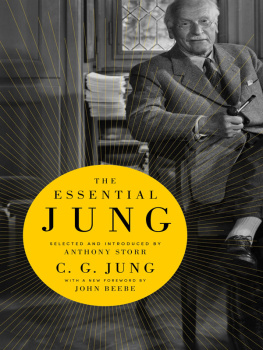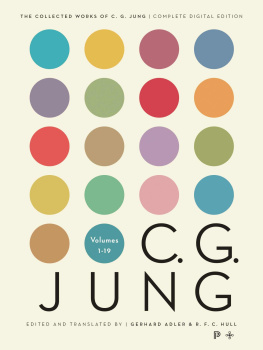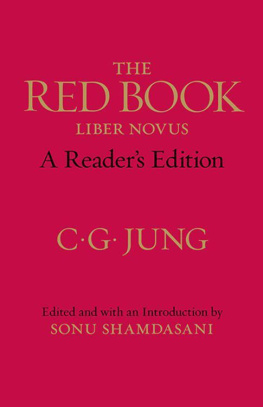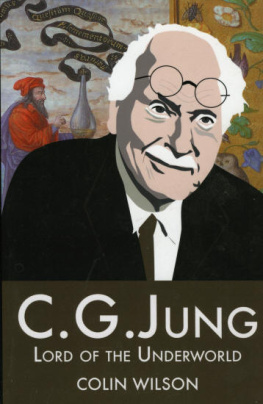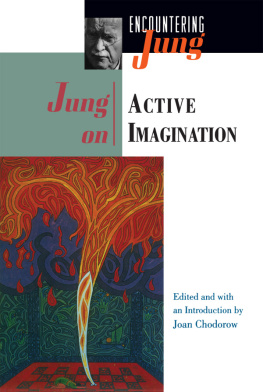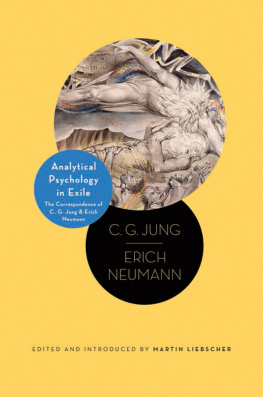Contents
Guide
Page List
THE ART OF
C.G. JUNG
Edited by the Foundation of the Works of C.G. Jung
Ulrich Hoerni Thomas Fischer Bettina Kaufmann
Translated from the German by
Paul David Young and Christopher John Murray
W. W. Norton & Company
Independent Publishers Since 1923
New York | London
CONTENTS
by Daniel Niehus
by Ulrich Hoerni
by Thomas Fischer and Bettina Kaufmann
by Medea Hoch
by Diane Finiello Zervas
by Jill Mellick
by Thomas Fischer
by Ulrich Hoerni
Ex Libris C.G. Jung, 1925 ()
The success of the facsimile edition of The Red Book, published in 2009 by W. W. Norton, is proof of an enormous interest in Jungs visual and creative works. For the first time Jung became visible to a wider audience not only as a founding figure of modern psychology, but also as an artist in his own right. Exhibitions of The Red Book itself in renowned art institutions in the United States and Europe, culminating in its showing as the centerpiece of the Venice Arts Biennale 2013, attracted attention from far beyond the circles already familiar with Jungs life and work. Realizing the growing demand for more complete and informative documentation of Jungs creative legacy, the Foundation of the Works of C.G. Jung decided to undertake a new publication presenting this material in a volume dedicated exclusively to Jungs visual work.
The cover illustration from The Red Book chosen for this volume highlights some of the unique features characteristic of Jungs artwork: the combination of freedom in color, motif, and perspective displaying similarities to the development in modern art of the early twentieth century; the play with light and shadows to create perspective and dimensionality; the use of transparent and opaque techniques to create plasticity and light effects as seen in the central symbolic abstraction seemingly suspended in midair depicted against a dark background; the working in a very free and unrestricted manner exemplified in the use of mosaic patterns for the modeling of the tree bark, lending the object almost animistic qualities.
Here is an imaginative language that for many opens up a new way of knowing the work of this exceptionally creative man. The inclusion of previously unpublished drawings, paintings, and sculptures in The Red Book and related exhibitions lifted the veil on the remarkably broad spectrum of visual works produced by Jung. Further searches have since led to the discovery of early drawings from childhood and adolescence.
Jung himself never wanted to be considered an artist. While he included illustrations in some of his texts during his lifetime, he always ensured that he remained anonymous as their creator. Most of these works remained unacknowledged until the publication of The Red Book brought their authorship to light. For a book called The Art of C.G. Jung ever to be published is remarkable and, finally, allows us to present the substantial corpus of Jungs creative work in the context of his intellectual and personal development.
There are many people to thank for making this publication possible, yet one person stands out in particular: the presentation of this material would not have been possible without the dedicated work of Ulrich Hoerni, grandson of C.G. Jung and Emma Jung-Rauschenbach, the first director of the Foundation of the Works of C.G. Jung and longtime chairman of the former Society of the Heirs of C.G. Jung. As far back as the early 1990s he started to pick up the pieces and began compiling an inventory of all of Jungs surviving visual works. Over the course of two decades he travelled widely and interviewed many people, including members of the family and those close to Jung who were still alive, the aim being to document the whereabouts of works and to collect information on them. Particularly helpful were comments by Jungs close collaborator Marie-Louise von Franz and his son, Franz Jung. After the publication of The Red Book in 2009, Ulrich Hoerni returned to completing the task with a view to laying the ground for a publication of Jungs remaining visual works.
In 2013, Thomas Fischer took over as director of the foundation, and, together with the foundations new collaborator, Bettina Kaufmann, joined Ulrich Hoerni on the project. With the support of the foundations board, they coordinated and advanced what has now become the first-ever editorial project under the full responsibility of the Foundation of the Works of C.G. Jung. Along the way they were assisted by Lorenz Homberger, former curator at the Rietberg Museum Zurich, who acted as a consultant to the project, as well as Medea Hoch, who, as well as contributing an essay to the book, worked closely with the editorial committee to bring all the texts, commentaries, and the selection of images into shape. I would like to thank wholeheartedly everybody involved with the Foundation of the Works of C.G. Jung for the work and dedication they have put in this project.
Another person who has been key to this undertaking and deserves special recognition is Andreas Jung, another grandson and the owner of the Jung Family Archive, which preserves large parts of the works included in this volume. He signaled full support for the project early on, and he and his daughter Susanne Eggenberger-Jung, together with Eva Middendorp, provided access to information about the items presented, whenever needed. They are joined by a number of institutional and private owners of individual visual works by Jung, which we would all like to thank for their help and agreement in obtaining high quality photographs of the objects in their possession. Their names are listed in the catalogue entries, unless they have asked to remain anonymous.
Along with the essays and catalogue entries written by the members of the editorial committee, Diane Finiello Zervas and Jill Mellick each contributed an essay on specific aspects of Jungs visual work. We are particularly grateful to them for their willingness to share the results of their ongoing research for this publication.
Photographers Alex Wydler and Rainer Wolfsberger in Zurich produced most of the new image material for this volume, and Laura Lindgren in New York has done a wonderful job on the design of the book. We would like to thank all three of them for their excellent work. A special mention is also due to translators Paul David Young in the U.S. and Christopher John Murray in the UK who have worked with the editors and the publisher on bringing the English version of the texts for this publication into fine shape. Others that lent a hand or assisted with information in the production of the catalogue include Christian Huber and Yvonne Voegeli from the ETH Zurich University Archives (C.G. Jung Papers collection), Vicente de Moura from the picture archive at the C.G. Jung-Institut Zurich in Ksnacht, Monika Metzger and Andreas Schweizer at the library of the Psychology Club Zurich, the members of the C.G. Jung Stiftung Bollingen-Jona, Jost Hoerni, Hans Hoerni, Andreas and Marianne Fischer, Felix Walder, Eric Baumann, Christine Benz, Carl C. Jung, Sonu Shamdasani, Martin Liebscher, Daniel Minder, Taddeo Lozano, Robert Hinshaw, Reto Brunner, Hsin-Mei Chung Messmer, Corina Fisch, Susanna Wettstein, Giampaolo Russo, Peter Fritz and Annkathrin Wollert from the Fritz literary agency in Zurich, Alex Anderfuhren and Jann Jenatsch at Keystone, as well as Hugh Milstein from Digital Fusion in California.


